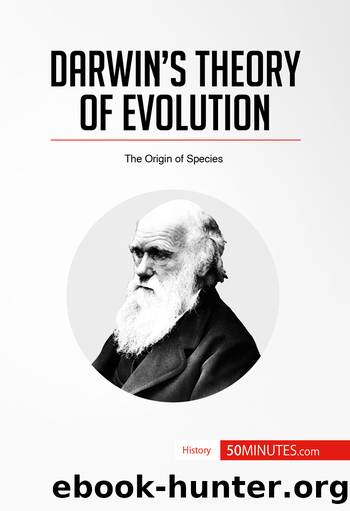Darwin's Theory of Evolution by 50Minutes.com

Author:50Minutes.com
Language: eng
Format: epub
Publisher: 50Minutes.com
Published: 2016-03-15T00:00:00+00:00
Darwin’s finches, 1845.
Likely to have descended from a common ancestor on the American continent, these birds have changed over time to suit the harshness of the environment of the Galapagos Islands. With food being limited, the species have evolved to include specific traits based on the food available on each island. Some have become seed-eaters, while others are insectivores. But even within the first category, individualities exist: indeed, some feed on harder, larger seeds, which only a stronger beak could split, while others feed on smaller seeds that are easier to eat, providing the necessary explanations as to the many types of beak that can be found on this bird.
Even today, “Darwin’s finches” are studied to observe the evolution of the species. Thus, during periods of drought, when food is less abundant, biologists are seeing a decline in the population of small-beaked finches, as they are not able to crack the larger seeds like the large-beaked finches, which can feed on everything. This discovery thus shows that the most adapted species will survive over the less adapted. Although Darwin did not speak of natural selection when he discovered the finches, he was nevertheless convinced of the variation of the species and speciation (formulation of new species).
With the Beagle ’s mission coming to an end, the return to Britain could finally begin. On 20 October 1835, the vessel left the Galapagos and successively reached Tahiti, New Zealand and Australia. In April, it reached the Cocos Islands (Indian Ocean islands), where Darwin developed his theory on the formation of atolls. He was also fascinated by coral, whose various branches inspired his evolutionary trees (where the species go in multiple directions). Finally, after traveling through Mauritius, Cape Town, and the island of St. Helena, the ship arrived in Britain on 2 October 1836. During the trip, Charles Darwin had written 770 pages of notes and collected 1 529 species preserved in alcohol and 3 907 “dry” species. With such a vast basis of materials, the naturalist’s reflection on his findings could continue for years.
Download
This site does not store any files on its server. We only index and link to content provided by other sites. Please contact the content providers to delete copyright contents if any and email us, we'll remove relevant links or contents immediately.
Fanny Burney by Claire Harman(25784)
Empire of the Sikhs by Patwant Singh(22171)
Out of India by Michael Foss(16312)
Leonardo da Vinci by Walter Isaacson(11901)
Small Great Things by Jodi Picoult(6093)
The Six Wives Of Henry VIII (WOMEN IN HISTORY) by Fraser Antonia(4789)
The Wind in My Hair by Masih Alinejad(4424)
The Lonely City by Olivia Laing(4119)
The Crown by Robert Lacey(4105)
A Higher Loyalty: Truth, Lies, and Leadership by James Comey(4031)
The Iron Duke by The Iron Duke(3639)
Millionaire: The Philanderer, Gambler, and Duelist Who Invented Modern Finance by Janet Gleeson(3568)
Sticky Fingers by Joe Hagan(3454)
Alive: The Story of the Andes Survivors by Piers Paul Read(3309)
Papillon (English) by Henri Charrière(3269)
Joan of Arc by Mary Gordon(3257)
Stalin by Stephen Kotkin(3084)
Aleister Crowley: The Biography by Tobias Churton(3019)
Ants Among Elephants by Sujatha Gidla(2924)
